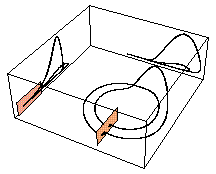
The present paper introduces a new chaos suppression method that is able to stabilize N-dimensional flows by perturbing in a discrete way the system variables through both proportional and additive changes when the flow crosses a suitably chosen Poincare section. The perturbations are applied to the corresponding N-1-dimensional Poincare map, or, in the case of strongly dissipative systems, to a suitable 1-dimensional Lorenz map. The method is applied to two different three variable flows: Rossler spiral chaos model and an isothermal three-variable autocatalator model introduced by Peng et al.
In the last two decades many researchers have studied the behavior of many non-linear dynamical systems (see Jackson 1991), including the appearance of deterministic chaos, that is characterized by the sensitive dependence on the initial conditions of a trajectory of the system. Deterministic chaos is usually associated with wild oscillations in the variables that may be inconvenient in practical applications of the systems exhibiting these features and, thus, for many applications one would like the system to have a more regular behavior. Although a chaotic system may appear at first sight to exhibit stochastic behavior, its deterministic nature implies that it has some regularity in its inner structure. In fact, it has been shown [Auerbach et al.1987] that a chaotic system may bee seen as the superposition of a large number of unstable periodic orbits (also called cycles). The idea of controlling chaos [Ott et al.1990] consists precisely in the stabilization of any of these orbits embedded in the strange attractor.
Different classes of methods have been suggested in the literature for the suppression of chaotic behavior in non-linear systems. Within the framework of the original method due to Ott, Grebogi, and Yorke (OGY) [Ott et al. 1990], one uses a Poincare section of the system in order to reduce in one the dimensionality of the system, skipping the direction having Lyapunov exponent equal to zero. The fixed point of the return map corresponding to the desired orbit of the flow is then stabilized by means of a linear approximation in a trust ball around this point. In practice, this is carried out by exploiting the saddle character of these unstable periodic orbits, namely by making the trajectory to lie at each crossing on the stable direction, called stable manifold, of the target orbit.
In a recent contribution [Matías and Guémez, 1994] a new method that operates by performing changes in the system variables has been suggested and applied to the case of some typical three-dimensional flows, although its capabilities to deal with maps, i.e. difference equations, have been also proved. An implementation of the OGY method in which time-dependent changes are applied on the system variables has been recently suggested [Sepulchre and Babloyantz 1993]. In the case of flows one of the useful features of the OGY method is that the perturbations are applied in a natural time scale of the flow, namely each time that a crossing with the Poincare plane occurs. Instead, in the case of the method introduced in [Matías and Guémez, 1994] an arbitrary time scale for the perturbations is introduced. Thus, one may wonder whether the application of still non-specific changes in the system variables through a return map will be more efficient in achieving chaos suppression, in the sense that smaller perturbations need to be applied, and this is the aim of the present publication. If the method proves to be robust enough, its main virtue can be that no prior knowledge of the system is needed, unless the OGY method.
This method applies perturbations on the system variables in two different forms. In the first method the pulses are proportional x -> x (1 + p). The second method tries to offer a simpler alternative through the use of additive pulses, x -> x +p, where p is the pulses strength.
For example, the Rossler model is given by the following set of coupled differential equations and that exhibit deterministic chaos for certain values of the parameters [Rossler, 1976]
x'=-y - z
y'=x + a y
z'=b + z (x - c)
In this paper the following parameter values exhibiting deterministic chaos have been chosen: a=0.2, b=0.2, and c=4.6. Fixing a and b to these values and considering c as the control parameter the model exhibits a Feigenbaum's period-doubling route to chaos.

The results of the application of the chaos suppression algorithm based on proportional perturbations on the system variables are shown in the followinf figures. The Poincare section has been defined in such a way that x=0 and x'>0, i.e., only one of the possible crossings of the flow with the Poincare cross-section x=0 is considered, and the perturbation is applied on both y and z.


References: